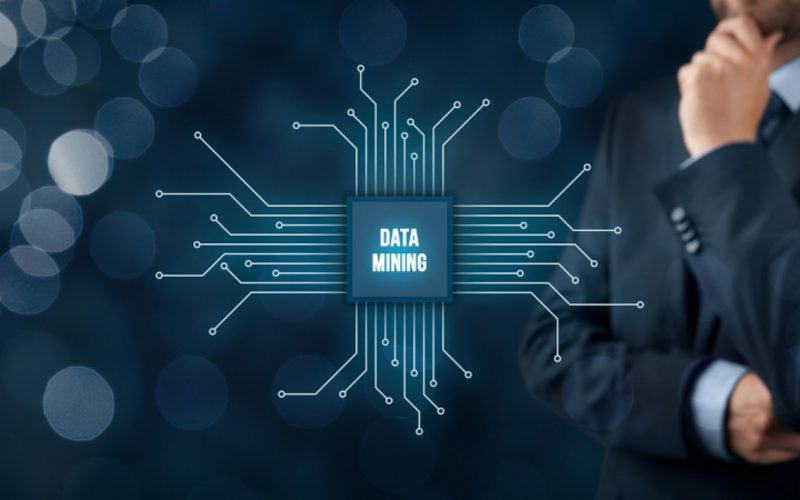Data mining isn’t a new concept, neither did it accompany the digital revolution. The concept has been around for almost a century, although it became more popular in the 1930s. In 1936, Alan Turing proposed the idea of a universal machine that could perform computations using techniques of present-day computers; which was one of the first models of data mining.
Since then, we’ve gone a long way. Data mining and machine learning have become viable tools in businesses that help to improve everything from sales operations to financial analysis for investment purposes. As a result, data scientists are now more important to businesses around the world.
What is Data Mining?
In simple terms, it is the process of analyzing large amounts of data in order to uncover business intelligence that can assist firms in solving problems, reducing risks, and seizing new possibilities. The similarities between looking for important information in a vast database and mining for ore on a mountain inspired the name of this system. Both procedures need combing through massive amounts of data in order to uncover hidden value.
Data mining provides answers to business questions that were, in the past, too time-consuming to answer manually. For the most part, it helps users find patterns, trends, and relationships that they might otherwise overlook. This is achievable by employing a variety of statistical tools to examine data in various ways. Consequently, this information help to forecast what will happen in the future and take action to impact business outcomes.
The use of data mining is prominent in business sectors like sales and marketing, product development, healthcare, and so on. When done properly, data mining gives you a significant competitive advantage by allowing you to understand more about your customers. This eventually leads to the development of successful marketing strategies, revenue improvement, and proper cost management.
Read Also: Data-Driven Decision Making and Marketing
How Data Mining Works
Exploring and analyzing enormous chunks of data to find relevant patterns and trends is what data mining is all about. And besides the benefits above, other areas it comes in handy include; database marketing, credit risk management, fraud detection, spam email screening, and even determining user attitude.
Meanwhile, there are four steps in the data mining process. Organizations begin by gathering data and loading them into data warehouses. The data is then stored and managed, either on-premises or in the cloud.
Data is accessed by business analysts, management teams, and information technology specialists, who then decide how to organize it. The application software then takes over. It sorts the data depending on the user’s responses, after which it presents the data in an easy-to-share format, such as a graph or table, by the end-user.
The Process of Data Mining
Data mining involves a series of stages, from data collection through visualization, in order to extract useful information from massive data sets. Data mining techniques basically help to produce descriptions and predictions about a target data set. The process below reveals how this is achievable.
#1. Define the Business Objectives:
This is often the most difficult part of the data mining process, even though many companies tend to overlook this crucial stage.
At this point, data scientists and business stakeholders must collaborate to ascertain the business problems. This will guide the data queries and parameters for a specific project. However, analysts may need to conduct additional research to fully comprehend the business context.
#2. Data Preparation:
Once the extent of the problem is determined, data scientists will be able to determine which collection of data will help them answer the essential business questions more easily.
They literally clean the data after collecting it, removing any noise such as duplicates, missing numbers, and outliers. Meanwhile, an additional step may be required, depending on the dataset. The aim is to decrease the number of dimensions, as having too many features can slow down any subsequent computation. To guarantee optimal accuracy in any models, data scientists will look to keep the most important predictors.
#3. Modeling and Pattern Mining:
Data scientists may look at any intriguing data linkages, such as sequential patterns, association rules, or correlations, depending on the type of research. But while high-frequency patterns offer a wider range of uses, data variations can sometimes be more fascinating, exposing potential fraud areas.
Depending on the available data, deep learning algorithms can come in handy when classifying a data collection. If the input data is labeled (supervised learning), a classification model or a regression can be used to categorize the data, or just regression can be used to forecast the plausibility of a specific task.
On the other hand, individual data points in the training set are compared to one another to uncover underlying similarities, then assembled based on those characteristics if the dataset isn’t labeled (i.e. unsupervised learning).
#4. Evaluation of Results and Implementation of Knowledge
After the data has been aggregated, the results must be examined and understood. When it comes to finalizing outcomes, they should be valid, unique, valuable, and easy to comprehend. If this criterion is met, organizations can then utilize this information to develop new strategies that will help them achieve their goals.
Data mining Example
Data mining techniques are widely used in grocery stores. Customers can get free loyalty cards from several supermarkets, which give them access to special discounts not available to non-members. In other words, stores can easily track who is buying what, when they are buying it, and at what price using the cards. After analyzing the data, retailers can use it to offer customers coupons on the basis of their purchasing practices. They can also determine when to put items on sale or sell them at full price.
When a corporation uses only selected information that hardly reflects the total sample group to establish a theory, data mining might be a reason for worry.
Techniques for Data Mining
To turn enormous amounts of data into meaningful information, data mining employs a variety of algorithms and methodologies. Here are some of the most common ones:
#1. Association Rules:
The term “association rule” refers to a rule-based method for determining associations between variables in a dataset.
Market basket analysis, which allows organizations to better understand linkages between different items, basically employs these methodologies. Businesses may develop stronger cross-selling strategies and recommendation engines by understanding their customers’ consumption habits.
#2. Neural Networks:
Neural networks help to handle data by simulating the interconnection of the human brain through layers of nodes. Inputs, weights, a bias (or threshold), and an output make up each node.
If the output value reaches a certain threshold, the node “fires” or “activates,” sending data to the network’s next layer. Through supervised learning, neural networks learn this mapping function, then alter it based on the loss function using gradient descent.
We can be sure of the model’s accuracy to produce the correct answer when the cost function is at or near zero.
#3. Decision Tree:
This data mining technique groups or predicts potential outcomes based on a collection of decisions using classification or regression methods. It uses a tree-like image to show the potential results of these decisions, as the name implies.
#4. K-nearest neighbor (KNN):
This is a non-parametric technique that classifies data points based on their proximity and relationship to other available data. This technique assumes that data points that are comparable can be discovered close together. As a result, it attempts to determine the distance between data points, using Euclidean distance, and then assigns a category based on the most common category or average.
Applications of Data Mining
Business intelligence and data analytics teams are increasingly using data mining techniques to obtain insights for their organizations and industries. The following are some examples of data mining applications:
Sales Forecasting
Sales forecasting is one way to make use of the links revealed by data mining algorithms.
The use of data mining tools to answer a business problem concerning what will sell and when is known as sales forecasting.
Read Also: Sales Forecasting Software: 15+ Best 2021 Options(+ Free Tips)
Walmart, for example, makes extensive use of the data gathered by its data miners. According to Walmart’s research, when there were storm warnings in the area, individuals were more likely to buy strawberry Pop-Tarts. The strawberry Pop-Tarts were then strategically placed at the checkouts by Walmart.
Walmart’s business questions (what do customers buy when hurricanes are approaching?) were solved through data mining by boosting impulse purchases at checkouts (people buy more strawberry Pop-Tarts).
However, this is a fairly broad definition of data mining; trying to anticipate everyone’s actions.
Market segmentation
Market segmentation is one of the most powerful features of data mining. It can be thought of as a form of grouping.
A corporation might examine the information gathered and begin to make business decisions based on criteria such as age or gender.
Say we collect information about iPhone purchases, for example. When we combine our data, we discover that those under the age of 30 are more likely to purchase an iPhone. A data scientist could advise Apple’s marketing team to target ads to people under the age of 30.
We’re building prediction models here since we know what we want to sell and are trying to figure out who we should market to.
That’s just one example; you can get a lot more specific. We may further divide our market based on gender, race, and credit score. Then we might discover that the target market for iPhones is white women under 30 with outstanding credit ratings.
The possibilities for segmentation are limitless and solely dependent on the data you have.
Education
Educational institutions have begun to collect data in order to better understand their student populations and the settings that promote success. Basically, as more courses move to online platforms, instructors can track and evaluate performance using a variety of dimensions and metrics, such as keystrokes, student profiles, classes, universities, and time spent.
Optimization of Operations
Process mining makes use of data mining techniques to cut costs across operational tasks, allowing businesses to operate more efficiently. This assists business owners in identifying costly bottlenecks and improving decision-making.
What You Mean by Data Mining?
Data Mining is a concept most companies utilize to transform raw data into meaningful information. Businesses basically learn more about their customers by employing software to seek trends in massive batches of data. This allows them to design more successful marketing campaigns, improve sales, and cut costs. Effective data collection, warehousing, and computer processing are all required for data mining.
What Data Mining Is Used For?
The use of data mining is prominent in business sectors like sales and marketing, product development, healthcare, and so on. When done properly, data mining gives you a significant competitive advantage by allowing you to understand more about your customers. This eventually leads to the development of successful marketing strategies, revenue improvement, and proper cost management.
What Is Data Mining and How It Works?
Organizations begin by gathering data and loading them into data warehouses. The data is then stored and managed, either on-premises or in the cloud. Data is accessed by business analysts, management teams, and information technology specialists, who then decide how to organize it. The application software then takes over. It sorts the data depending on the user’s responses, after which it presents the data in an easy-to-share format, such as a graph or table, by the end-user.
What Are the 3 Types of Data Mining?
Some types of data mining are:
- Clustering.
- Prediction.
- Classification.
What Are the 7 Steps of Data Mining?
- Data Cleaning.
- Data Integration.
- Data Reduction
- Data Transformation.
- Data Mining.
- Evaluation of patterns
Related Articles
- Types of Analytics: How to Apply them in any Business
- What is Sales Forecasting? Methods and Real-world Examples
- FORECASTING METHODS: Definitive Guide to Forecasting
- Business Forecasting Definition, Methods, Examples, Types (Updated)
- Predictive Analytics: Definition, Examples, and Benefits
- Predictive vs Prescriptive Analytics, Explained!!! (+ Detailed Guide)
- Demand Forecasting: Methods, Examples, Models (+ Detailed Guide)






